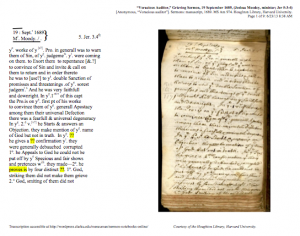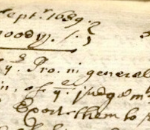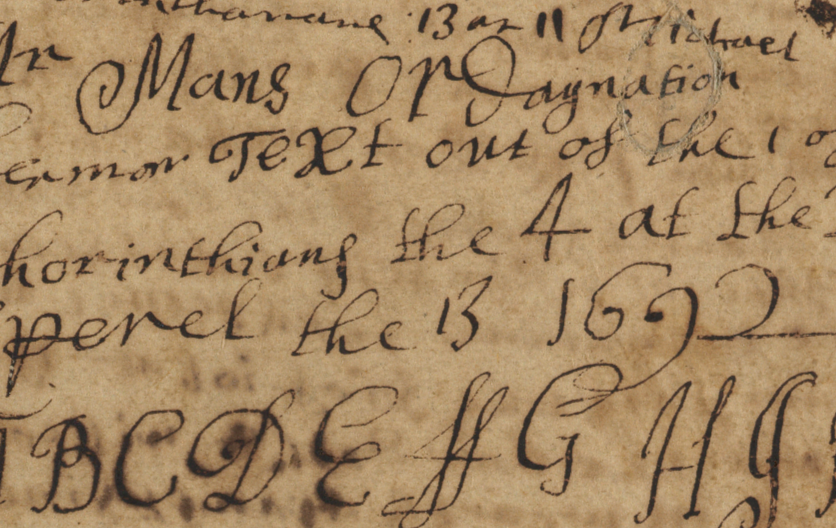The first transcription is now available! You can try reading the sermon on your own, consult a side-by-side transcription, ask questions, and offer comments.
To receive updates on new transcripts as they become available, send a request to auntiequarian@clarku.edu. To get involved in transcriptions yourself, click the GET INVOLVED link.
Why collaborative transcription? Why side-by-side? Why online?
 On the most practical level, online collaborative transcription is a matter of access. This site is an experiment in sharing the onerous work of transcription by breaking it down into less onerous pieces. Transcribe one page, comment on one ambiguous reading, decipher one impossible word, and you will contribute to the whole. The more transcriptions we can put online, the more people will have access to fascinating but rather inaccessible archive.
On the most practical level, online collaborative transcription is a matter of access. This site is an experiment in sharing the onerous work of transcription by breaking it down into less onerous pieces. Transcribe one page, comment on one ambiguous reading, decipher one impossible word, and you will contribute to the whole. The more transcriptions we can put online, the more people will have access to fascinating but rather inaccessible archive.
One of my favorite quotes on the subject of transcribing manuscripts comes from Douglas H. Shepard in his introduction to “The [Henry] Wolcott Shorthand Notebook Transcribed” (Ph.D. diss., State University of Iowa, 1957). Reflecting on the arduous work of deciphering an entire shorthand notebook–and on the ultimate uncertainty of some readings–Shepard muses:
I can only suggest that colleges and universities set up courses that should have been in the curriculum for years–seminars in skepticism and lingering doubt: fallibility and the printed page. (13)
If we are lucky, we can decipher the manuscripts we want to read. But the realities of the manuscript archive is that some questions remain unanswered and some conclusions remain elusive. At the most basic level, handwriting can be impossible to read, pages can be torn, allusions might be long forgotten. The larger issue for me, however, is that manuscripts such as the sermon notebooks invite us to consider the subjectivity of the individual’s experience, and yet we can only grasp at the insights they offer like so much straw.
I take Shepard’s comment on the limits of certainty as a suggestions for how we might deal with this curious manuscript archive. Instead of fighting to solve (or worse yet cover up) “skepticism and lingering doubt,” we might embrace the creative analysis that uncertainty demands. Perhaps “fallibility and the printed page” will then be less a burden to overcome than a reason to enter into more fully engaged conversations about the many ways that manuscripts and other material artifacts can signify.
And then there is the pure pleasure of the manuscript page. No matter how conscientiously executed, the transcription can never convey all the delightful idiosyncrasies of the handwritten page itself. The labors of the pen to make marks on the page, the real chemistry as ink and paper interact, the complex dimensionality of the individual leaf. These material-textual artifacts are worthy of both aesthetic contemplation and methodological inquiry.
Read more on my method and rationale for sermon notebook transcription here:


